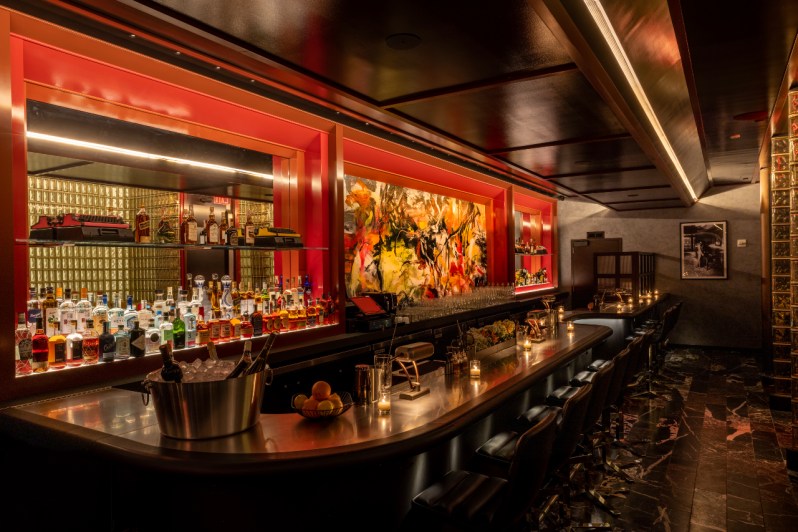
From the classic espresso martini to innovative coffee negroni creations, coffee and alcohol are classic combinations with endless possibilities. We spoke to Hernán Trujillo, general manager of The Boardroom, a recently opened speakeasy in Midtown Manhattan, to learn all about these coffee libations. Opened by brothers Eric and Jesse Jacobs of Fashioned Hospitality, The Boardroom is a sophisticated lounge offering a range of classic and innovative cocktails, with some of the best options being coffee-themed.
“Coffee is such a great ingredient when working with cocktails because of the amount of different flavor affinities it has,” explained Trujillo. “Through contrast and complementation, coffee can be paired with a variety of ingredients, as well as alter the flavor profile of a cocktail through a multitude of applications. Though you should always be aware of your caffeine intake.”
Why is coffee such a great cocktail ingredient?
Chocolatey, fruity, floral, or acidic, coffee beans span various tastes. Because of this wide range of flavor profiles, plenty of potential ingredient pairings exist. However, a key component of an excellent coffee cocktail recipe is the quality of the coffee bean itself.
“In my opinion, choosing the right coffee bean depends on your intention with the cocktail you are creating,” said Trujillo. “Think about which tasting notes from the coffee beans you are trying to use and how it would affect the flavor profile. Most may lean toward a more robust, rich bean with notes of chocolate, like a Robusta bean. Or maybe a bean with a smoky but still fruity and floral profile like a liberica bean. As far as preparation goes, I implore others to get as creative as possible when it comes to the application of coffee to your ingredients.”
Once the right beans are selected, the flavor profiles are next to focus on. Trujillo takes a lot of inspiration from the book The Flavor Bible by Andrew Dornenburg and Karen A. Page, stating that the book helped “bring awareness of how profiling flavors work, as well as what flavors naturally go together and contrast. Also, just understanding how a palate works.” For instance, some of Trujillo’s favorite ingredients to pair with coffee include vanilla, honey, and citrus.
How to craft the perfect coffee cocktail
“For me, every cocktail should have a story,” said Trujillo. “Whether it is historical purpose, originality, or to test uncommon waters in flavor profiles that are new to you, I believe that each cocktail should have some sort of story that really defines the thought process behind it. Having purpose or a direction for the creative notion is what separates someone tending a bar and a mixologist. More commonly accepted as we move into a new era of cocktails.”
This careful attention to storytelling in the creative process might seem intimidating for someone at home, but it’s important to keep in mind an important element — having a sense of fun. For those at home interested in making coffee cocktails, don’t be intimidated by the scale of possible ingredients or the sheer complexity of high-quality coffee beans; the point is to realize that this process is an adventure.
“I’d suggest following recipes from others who have already tested it out and worked out the kinks,” explained Trujillo. “For the adventurous ones, I would say be as creative as you can be and try things no one has tried before, but have an intention when doing so, as this will provide the parameters necessary not to get lost when creating a cocktail.”

Spanish Coffee
Ingredients:
- 1 1/2 ounces vanilla & cocoa bean-infused Maestro Dobel Diamante Reposado Cristalino tequila*
- 1/2 ounce Starbucks cold brew concentrate
- 3/4 ounce Mr. Black Cold Brew Coffee Liqueur
- 1/4 ounce fresh orange juice
- 1/4 ounce fresh pineapple juice
- 1/2 ounce cinnamon agave syrup**
- 2 dashes spiced cherry bitters (20 droplets)
- About 1 ounce of Fever Tree Cola
- For garnish: mint bouquet
Method:
- Add the first 7 ingredients to a cocktail shaker.
- Shake and strain into a highball glass filled with crushed ice.
- Top with Fever Tree Cola and garnish with a mint bouquet.
* Vanilla and cocoa bean infusion will take 3 days. Split 3 vanilla beans and add 3/4 cup of cocoa nibs to 1 1/2 liter bottle of Tequila. (Preferably a Cristalino).
**Cinnamon Agave Syrup is 2 parts agave nectar and 1 part water. First, steep 2 cinnamon sticks in a pot with water as you bring it to a simmer. Once simmering, add agave nectar and stir. Once mixed, turn off the heat, add the lid, and let rest until cooled. Refrigerate until ready to use.

Black Manhattan
Ingredients:
- 1 3/4 ounces Old Forester 1897 Bottled in Bond Bourbon
- 1 ounce Mr. Black Coffee Amaro
- 1/4 ounce Carpano Antica
- 1/4 teaspoon pomegranate molasses
- 2 dashes of Angostura bitters
- 1 dash mole bitters (10 droplets)
- 1 dash saline*
- For garnish: skewered Luxardo cherries
Method:
- Stir together all the ingredients except for the garnish, then strain into a Nick & Nora Glass.
- Garnish with skewered Luxardo cherries.
*Saline is 1 part salt and 1 part water. Bring water to boil in a pot, then add salt. Let sit on heat until fully dissolved. Let cool, then refrigerate until ready to use.



